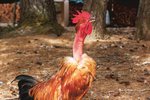
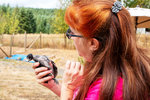
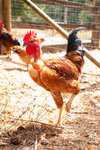
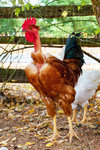
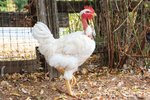
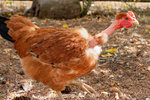
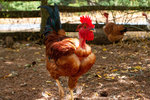
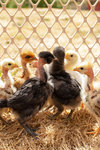
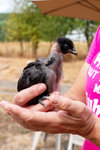
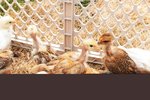

Back in March, heart-throb pop star Harry Styles daringly brought back the feather boa, setting off a chain reaction of headlines heralding the hip look.
But if feather-clad necks are back in vogue, somebody better tell Winlock’s newest residents — the flock of “naked neck” chickens being raised by Roxi Willoughby.
The clucking cuties arrived this spring, appropriately making a home in the town of the world’s largest egg and much-celebrated “Egg Days.” They appear funny-looking at first, with their 50% less feathers eliciting double-takes.
Willoughby herself initially thought they looked like vultures, and some have used the term “turkens” — suggesting they’re a cross between a chicken and a bare-necked turkey.
“I hate that word,” Willoughby said, standing in her backyard last week as naked-necked roosters crowed behind her. “It seems like the serious breeders take great offense, so I try not to do it. They’re naked necks.”
On her blog, Willoughby celebrates “the chicken that’s already half plucked,” describing naked necks as a “confusing” and “divisive” breed.
Summing it up perfectly is chicken blog The Featherbrain, which asks of the breed: “Is she adorable, or is she hideous?” The site later describes naked necks as sweet, docile and cuddly.
If you ask Willoughby, the origins of the naked neck are murky, getting their start in Romania or perhaps Hungary.
Either way, the funky chickens haven’t had their big break in the United States yet, making it difficult to get your hands on some quality naked necks. It’s a surprise for Willoughby, who says the breed is tasty, friendly, hearty and easier to process.
“I gotta tell you, having half as many feathers to pluck is awesome,” she told The Chronicle. “I could pluck six in the time I’d normally take to do two.”
Their bare necks make them resistant to heat and less demanding of feed, since they don’t have to produce as many protein-packed feathers. Willoughby says they’re more resistant to chicken diseases, too. None of her chicks so far have contracted the sometimes-deadly coccidiosis.
“They’ve been around for years and there’s people that know about them. I’m surprised they’re not more popular, especially for homesteading,” Willoughby said, noting that now she thinks fully-feathered chickens are the strange-looking ones.
Walking between the “goat-zebos” and chicken coops her husband Rick put together, it’s easy to tell Willoughby loves her new flock — even if some of them will end up plucked and sent to “freezer camp.”
The couple moved to Winlock in 2014, making a home out of a 1904 Ainslie schoolhouse — a name shared with the community’s first timber company. Originally from Tacoma, Willoughby says she’s “always been a farmer at heart.” Now, finally enjoying rural life, she calls herself a “late bloomer” — the naked necks are her most recent COVID-19 project.
A less-than-popular breed in the U.S., hatcheries tend to breed all four naked neck colors together — mixing qualities serious breeders say should be kept separate. Now the hope is to get them back to tip-top shape, potentially selling hatching eggs and chicks by next spring.
But if you’re a naked neck trying to be up-to-snuff in terms of breeding standards, you’ve got your work cut out.
Everything from feather, foot and egg color, as well as neck naked-ness, will be judged. Willoughby even points out one chicken’s crooked toe as something compromising its quality.
Will the chickens be submitted to contests to show off their top-quality breeding? Probably not. When asked why she’s working to breed them to standard, Willoughby offered up: “for fun!”
“For me! It’s a COVID project. I need another hobby. I like to keep busy, because I’m very careful with COVID, so this is my new thing.”
Keep up to date on the flock on the “Winlock Naked Necks” Facebook page or at tinyurl.com/ypnehmsf.